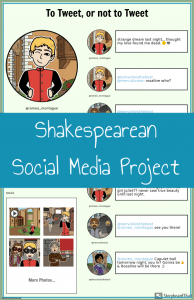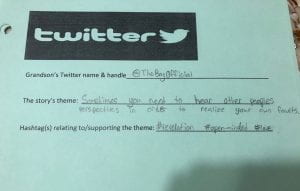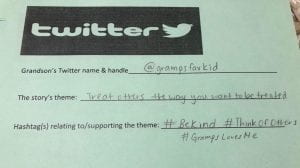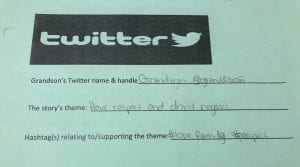One of my favorite applications for incorporating social media into the ELA classroom is the app, SocialDummy. This app allows users to create fake, inactive profiles and posts on a plethora of social media platforms, including Facebook, Twitter, Instagram, Snapchat, Youtube, text messages, etc. Use of  SocialDummy in the ELA classroom can consist of group projects asking students to connect the literature to their own lives and technology. Students can assume the persona of a character in the novel and create a Facebook profile or Tumblr page for that character, posting what they think that character would; or students can recreate plot points of the text through a social media platform (i.e. collages of happenings on Instagram or “Twitter Theater”). This participation in “unfiction” activities allows students to engage with social media within the classroom, sharing their practices, knowledge, and interests in the academic setting. As this platform is offline only, nothing can be posted to
SocialDummy in the ELA classroom can consist of group projects asking students to connect the literature to their own lives and technology. Students can assume the persona of a character in the novel and create a Facebook profile or Tumblr page for that character, posting what they think that character would; or students can recreate plot points of the text through a social media platform (i.e. collages of happenings on Instagram or “Twitter Theater”). This participation in “unfiction” activities allows students to engage with social media within the classroom, sharing their practices, knowledge, and interests in the academic setting. As this platform is offline only, nothing can be posted to  active social media or be used maliciously. It is self-contained and the only mediation required would be in-class monitoring during group work. In addition, the analytical advantages of assigning activities like these enhance engagement with the literature. Instead of writing a quick write on Romeo’s character traits, creating a Tumblr page allows students to think critically and intertextually at other forms of media that would represent Romeo’s character and mental state throughout the play. These media platforms encourage students to think much more deeply about the text by relating it to their time period and technology. It’s no longer dissociated literature, but relevant and interesting to their lives. Instead of thinking harder about how to write critically, students are able to think deeper about the text, its connections, and its applications.
active social media or be used maliciously. It is self-contained and the only mediation required would be in-class monitoring during group work. In addition, the analytical advantages of assigning activities like these enhance engagement with the literature. Instead of writing a quick write on Romeo’s character traits, creating a Tumblr page allows students to think critically and intertextually at other forms of media that would represent Romeo’s character and mental state throughout the play. These media platforms encourage students to think much more deeply about the text by relating it to their time period and technology. It’s no longer dissociated literature, but relevant and interesting to their lives. Instead of thinking harder about how to write critically, students are able to think deeper about the text, its connections, and its applications.
Even if educators who are not digital natives worry about bringing technology and social media into the classroom – or if your school district still has restrictions with some technologies – there are still a plethora of means with which to incorporate social media into the classroom. For example, during one of my placements in student teaching, the school district was extremely restrictive about which websites  and applications were approved. So, many of my lessons had to be modified to paper, as opposed to digital interaction. One of these assignments was a simple, “Twitter Theme” exercise for my 8th-grade class. Originally intended to be a Padlet activity, this activity asks students to create a Twitter handle, Tweet, and hashtags pertaining to the short story we had read in class. A very short line was left for the tweet/theme to align with Twitter post restrictions, which reminded students familiar with the medium of that limitation. This activity produced surprising and promising responses from my students, which I’ve included pictures of below! I was most surprised by the depth of responsiveness I got from my students. Some were creative in coming up with names of the characters, while others were creative in retaining the mystery and universality incurred by the characters of the story remaining unnamed. This was an excellent, quick activity that allowed students to demonstrate their learning by drawing on previous lessons and conversations weeks later to create their tweets.
and applications were approved. So, many of my lessons had to be modified to paper, as opposed to digital interaction. One of these assignments was a simple, “Twitter Theme” exercise for my 8th-grade class. Originally intended to be a Padlet activity, this activity asks students to create a Twitter handle, Tweet, and hashtags pertaining to the short story we had read in class. A very short line was left for the tweet/theme to align with Twitter post restrictions, which reminded students familiar with the medium of that limitation. This activity produced surprising and promising responses from my students, which I’ve included pictures of below! I was most surprised by the depth of responsiveness I got from my students. Some were creative in coming up with names of the characters, while others were creative in retaining the mystery and universality incurred by the characters of the story remaining unnamed. This was an excellent, quick activity that allowed students to demonstrate their learning by drawing on previous lessons and conversations weeks later to create their tweets.
Student Samples:
For more information about incorporating social media into the classroom, see:
De Kosnik, Abigail. “Is Twitter a Stage?: Theories of Social Media Platforms as Performance Spaces.” #Identity: Hashtagging Race, Gender, Sexuality, and Nation, edited by Abigail De Kosnik and Keith P. Feldman, University of Michigan Press, Ann Arbor, 2019, pp. 20–36. JSTOR, www.jstor.org/stable/j.ctvndv9md.5.
Jordan, Tim. “Social Media Networks.” Information Politics: Liberation and Exploitation in the Digital Society, Pluto Press, London, 2015, pp. 120–140. JSTOR, www.jstor.org/stable/j.ctt183p2xf.11.
Back to Educational Applications
Back to Final Project Homepage





